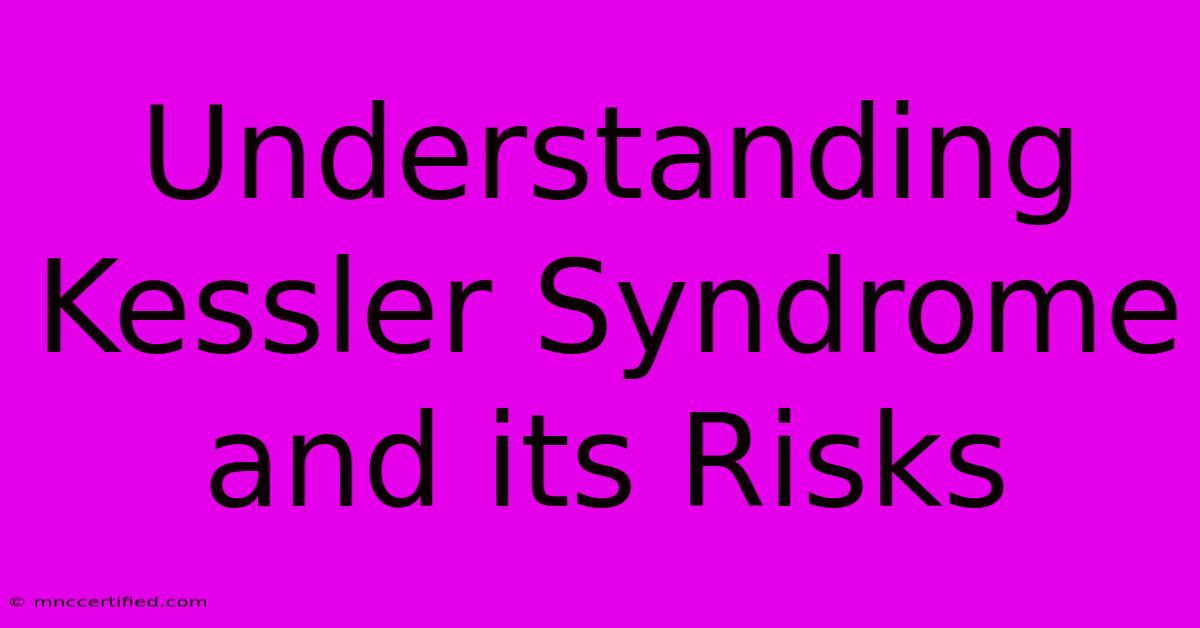Understanding Kessler Syndrome And Its Risks

Table of Contents
Understanding Kessler Syndrome and its Risks: A Cascade of Catastrophe
The vast expanse of space, once considered a pristine void, is increasingly becoming a cluttered junkyard. This accumulation of defunct satellites, rocket stages, and space debris poses a significant threat, not just to future space missions, but to the very fabric of our access to space. This threat is embodied by the ominous concept of Kessler Syndrome, also known as the collisional cascading effect. Understanding this phenomenon is crucial for mitigating its potentially catastrophic consequences.
What is Kessler Syndrome?
Kessler Syndrome describes a scenario where the density of objects in low Earth orbit (LEO) becomes so high that collisions between these objects generate a cascade of further collisions. Each collision fragments the existing debris, creating exponentially more pieces of space junk, which in turn increases the likelihood of further collisions. This creates a self-sustaining chain reaction, making LEO essentially unusable for future space exploration and satellite operations.
Imagine a game of cosmic billiards where the stakes are incredibly high. One collision triggers a chain reaction, rapidly increasing the number of "balls" (debris) in play, leading to a chaotic and potentially irreversible situation. This is the essence of Kessler Syndrome.
The Domino Effect of Space Debris
The primary concern isn't just the large pieces of debris, although those pose a considerable threat. The real danger lies in the sheer volume of smaller debris, often too small to track but still capable of causing significant damage to operational satellites and spacecraft. Even a tiny paint fleck traveling at orbital velocity can inflict catastrophic damage to a spacecraft's sensitive components.
This cascading effect exponentially increases the risk of:
- Satellite damage and loss: Collisions with debris can cripple or destroy valuable satellites, impacting global communication, navigation, weather forecasting, and other essential services.
- Spacecraft mission failure: Crewed missions and robotic probes are equally vulnerable, potentially resulting in the loss of life and billions of dollars in investments.
- Increased costs of space operations: The need to develop and implement sophisticated debris mitigation strategies will drastically increase the cost of space activities.
The Growing Threat of Space Junk
The amount of space debris is growing at an alarming rate. Thousands of defunct satellites and millions of smaller fragments currently orbit the Earth, posing an ever-increasing threat. Factors contributing to this escalating problem include:
- Increased space launches: The growing commercialization of space and increasing frequency of launches contribute to the accumulation of debris.
- Anti-satellite weapon testing: Deliberate destruction of satellites adds significantly to the debris field, exacerbating the problem.
- Natural events: While less frequent, meteoroid impacts and other natural events can also contribute to the generation of space debris.
Mitigating Kessler Syndrome: A Global Effort
Preventing the catastrophic realization of Kessler Syndrome requires a proactive and collaborative global effort. Several strategies are being explored and implemented, including:
- Improved satellite design: Designing satellites with features that allow for controlled de-orbiting at the end of their lifespan is crucial.
- Active debris removal: Developing and deploying technologies to capture and remove existing debris from orbit is a significant challenge but essential for mitigating the risk.
- International cooperation: Establishing clear guidelines and regulations for responsible space activities, including debris mitigation strategies, is vital.
- Space traffic management: Implementing sophisticated tracking and monitoring systems to better predict and avoid potential collisions.
Conclusion: A Future at Stake
Kessler Syndrome isn't just a theoretical possibility; it's a real and growing threat to our continued access to and utilization of space. Addressing this challenge requires a concerted global effort, prioritizing sustainable space practices, investing in debris mitigation technologies, and fostering international cooperation. The future of space exploration and the many vital services we derive from space-based technologies depend on it. Ignoring this problem will have severe consequences – a future where the vastness of space is rendered unusable due to our own carelessness. Ignoring Kessler Syndrome is not an option; mitigating its risks is a global imperative.

Thank you for visiting our website wich cover about Understanding Kessler Syndrome And Its Risks. We hope the information provided has been useful to you. Feel free to contact us if you have any questions or need further assistance. See you next time and dont miss to bookmark.
Featured Posts
-
Arsenal Climbs To Second 1 0 Victory
Dec 28, 2024
-
Razorbacks Set Liberty Bowl Record
Dec 28, 2024
-
Navy Vs Oklahoma Recap Dec 28 2024
Dec 28, 2024
-
Magas Disappointment Jasmines Musk Ramaswamy Analysis
Dec 28, 2024
-
Chat Gpt Service Disruption User Reports
Dec 28, 2024